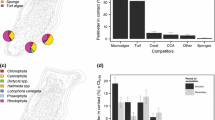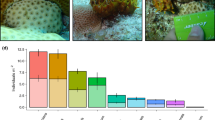Summary
The frequencies with which organisms of a species overgrew or were overgrown by organisms of other species in a marine epifaunal community were estimated. The ranking of the ability of the major taxonomic groups to overgrow others was basically hierarchical:ascidians≧sponges>bryozoans>barnacles, polychaetes, tubicolous amphipods, hydroids. In contrast, the ranking of the competitive ability of species in the community did not form a simple linear hierarchy and there was no single competitively dominant species (measured in terms of overgrowth). There were often no significant differences in the ability of species to overgrow each other within the three major taxonomic groups of sponges, ascidians and bryozoans. Such results were common also between the species of large sponges and ascidiams which dominated substrata immersed for periods longer than two years.
A lack of a significant difference in the competitive ability of species was usually the result of (a) frequent formation of delay/ties or “standoffs” and (b) changes in the outcome of interactions due to change in the relative size of interacting colonies. In many two-species interactions the species which had the larger colony in a given encounter had a greater probability of winning.
When the range of colony sizes of two species was similar there was often no significant difference between the competitive ability of each species. Such cases without a clearcut winner often represented a backloop in an otherwise hierarchical sequence of competitive ability, i.e. Species A beats Species B, Species B beats Species C, no significant differences in competitive ability between Species C and A. No examples of competitive networks of the form Species A beats Species B, Species B beats Species C, Species C beats Species A were found. Backloops in otherwise hierarchical sequences (no significant differences in competitive ability) occurred most frequently between species within the same major taxonomic groups and were the result of a very even balance in the generalised competitive mechanism of overgrowth.
It seems probable that backloops in hierarchical sequences are more commonly due to the absence of clear competitive dominance in interactions between species (reversals in the outcome of overgrowth interactions and “standoffs”), rather than to direct backloops formed by a specialised or to a generalised competitive mechanism. Network-like arrangements of competitive ability formed by the type of processes described here are likely to contribute significantly to the high levels of species diversity observed in many marine epifaunal communities subject to low levels of physical disturbance.
Similar content being viewed by others
References
Al-Ogily SM, Knight-Jones EW (1977) Antifouling role of antibiotics produced by marine algae and bryozoans. Nature (Lond.) 265:728–729
Ayling AL (1978). Population biology and competitive interactions in subtidal sponge dominanted communities of temperate waters. PhD Thesis, University of Auckland. pp 113
Birch LC (1957) The meanings of competition. Am Nat91:5–18
Bryan PG (1973) Growth rate, toxicity and distribution of the encrusting sponge Terpios sp. (Hadromerida: Suberitidae) in Guam, Marianas Islands. Micronesica 9:237–242
Burton M (1949) Notes on the ecology of sponges.Brit Sci News Lond 2:83–85
Buss LW (1976). Better living through chemistry: the relationship between allelochemical interactions and competitive networks. In: FW Harrison, RR Cowden (eds), Aspects of Sponge Biology, Academic Press, New York, pp 315–327
Buss LW (1979a) Bryozoan overgrowth interactions — the interdependence of competition for space and food. Nature (Lond) 281:475–476
Buss LW (1979b) Habitat selection, directional growth and spatial refuges: Why colonial animals have more hiding places. In: G Larwood and BR Rosen (eds), Biology and Systematics of Colonial Organisms. Academic Press, London and New York. pp 459–497
Buss LW (1980) Competitive intransitivity and size frequency distributions of interacting populations. Proc Nat Acad Sci USA 77(9):5255–5259
Buss LW, Jackson JBC (1979) Competitive networks: nontransitive competitive relationships in cryptic coral reef environments. Am Nat 113:223–234
Buss LW, Jackson JBC (1981) Planktonic food availability and suspension-feeder abundance: evidence of in situ depletion. J exp mar Biol Ecol 49:151–161
Connell JH (1961) The influence of interspecific competition and other factors on the distribution of the barnacle. Chthamalus stellatus. Ecology 42:710–723
Connell JH (1971) On the role of natural enemies in preventing competitive exclusion in some marine animals and in rainforest trees. In: PJ denBoer, and G Gradwell (eds), Dynamics of Populations. Centre for Agricultural Publishing and Documentation, Wageningen, the Netherlands. pp 298–312
Connell JH (1975) Some mechanisms producing structure in natural communities: a model and evidence from field experiments. In: ML Cody and JM Diamond (eds), Ecology and Evolution of Communities, Belknap Press, Harvard University, Cambridge. pp 460–490
Connel JH (1976) Competitive interactions and the species diversity of corals. In: GO Mackie (ed), Coelenterate Ecology and Behaviour. Plenum Press, NY pp 51–58
Connell JH (1978) Diversity in tropical rain forests and coral reefs. Science 199:1302–1310
Day RW (1977) The ecology of settling organisms on the coral reef at Heron Island, Queensland. PhD Thesis, University of Sydney. pp 356
Dayton PK (1971) Competition, disturbance and community organisation: the provision and subsequent utilisation of space in a rocky intertidal community. Ecol Monogr 41:351–389
Goodbody I (1961) Inhibition ofthe development of a marine sessile community. Nature (Lond) 190:282–283
Harris JA (1978) The ecology of marine epifaunal communities on the pilings of Portsea Pier. BSc (Hons) Thesis, Department of Zoology, University of Melbourne
Jackson, JBC (1977a) Competition on marine hard substrata: the adaptive significance of solitary and colonial strategies. Am Nat 111:743–767
Jackson JBC (1977b) Hatitat area, colonisation and development of epibenthic community structure. In: BF Keegan, PO Ceidigh, and PJS Boaden (eds), Biology of Benthic Organisms. Pergamon Press, London, 349–358
Jackson JBC(1979) Overgrowth competition between encrusting ectoprocts in a Jamaican cryptic reef environment. J Anim Ecol 48:805–824
Jackson JBC, Buss L (1975) Allelopathy and spatial competition among coral reef invertebrates. Proc Nat Acad Sci USA 72:5160–5163
Karlson R (1978) Predation and space utilisation patterns in a marine epifaunal community. J exp mar Biol Ecol 31:225–239
Karlson R (1980) Alternative competitive strategies in a periodically disturbed habitat. Bull Mar Sci 30:894–900
Kay AM (1980) The organisation of sessile guilds on pier pilings. PhD Thesis, University of Adelaide. pp 240
Kay AM, Keough MJ (1981) Occupation of patches in the epifaunal communities on pier pilings and the bivalve Pinna bicolor atEdithburgh, South Australia. Oecologia (Berl) 48:123–130
Lang JC (1971) Interspecific aggression by scleractinian corals. I. The rediscovery of Scolymia cubensis (Milne-Edwards and Haime). Bull Mar Sci 21:952–959
Lang JC (1973) Interspecific aggression by scleractiniancorals. II. Why the race is not only to the swift. Bull Mar Sci 23:260–279
Menge BA (1976) Organisation of the New England rocky intertidal community: Role of predation, competition and environmental heterogeneity. Ecol Monogr 46:355–393
Menge BA, Sutherland JB (1976) Species diversity gradients: synthesis of the roles of predation, competition and temporal heterogenity. Am Nat 110:351–369
Osman RW (1977) The establishment and development of a marine epifaunal community. Ecol Monogr 47:37–63
Paine RT (1966) Food web complexity and species diversity. Am Nat 100:65–75
Paine RT (1971) A short-term experimental investigation of resource partitioning in a New Zealand rocky intertidal habitat. Ecology 52:1096–1106
Paine RT (1974) Intertidal community structure. Experimental studies on the relationship between a dominant competitor and its principle predator. Oecologia (Berl) 15:93–120
Paine RT (1976) Size-limited predation:An observational and experimental approach with the Mytilus-Pisaster interaction. Ecology 57:858–873
Park T (1954) Experimental studies of interspecies competition. II. Temperature, humidity and competition in two species of Tribolium. Physiol Zool 27:177–238
Porter JW (1972) Predation by Acanthaster and its effect on coral species diversity. Am Nat 106:487–492
Porter JW (1974) Community structure of coral reefs on opposite sides of the Isthmus of Panama. Science 186:543–545
Russ GR (1979) The relationship of fish grazing to bryozoan and ascidian communities at Portsea Pier, Victoria, Australia (preliminary report). Abstract.In: MB Abbott and GP Larwood(eds), Advances in Bryozoology.Academic Press, London. pp 295
Russ GR (1980) Effects of predation by fishes, competition, and structural complexity of the substratum on the establishment of a marine epifaunal community. J exp mar Biol Ecol 42:55–69
Russ GR (1981)Patterns of establishment and subsequent change in the structure of a marine epifaunal community. PhD Thesis, University of Melbourne pp 186
Rutzler K (1970) Spatial competition among Porifera: solution by epizooism. Oecologia (Berl) 5:85–95
Sarà M (1970) Competition and co-operation in sponge populations. In: WG Fry (ed), The Biology of Porifera, Symp Zool Soc Lond No 25, pp 273–284
Siegel S (1956) Nonparametric statistics for the behavioural sciences. McGraw-Hill Book Co., NY
Stebbing ARD (1973a) Competition for space between the epiphytes of Fucus serratus L. J Mar Biol Ass UK 53:246–261
Stebbing ARD (1973b) Observations on colony overgrowth and spatial competition. In: GP Larwood (ed), Living and Fossil Bryozoa, Academic Press, London. pp 173–183
Sutherland JP (1974) Multiple stable points in natural communities. Am Nat 108:859–873
Sutherland JP (1978) Functional roles of Schizoporella and Styela in the fouling community at Beaufort, North Carolina. Ecology 59:257–264
Sutherland JP, Karlson RH (1977) Development and stability of the fouling community at Beaufort, North Carolina. Ecol Monogr 47:425–446
Vail L, Wass R (1978) Encrusting bryozoa exhibit linear growth. Search 9:42–44
Wood V, Seed R (1980) The effects of shore level on the epifaunal communities associated with Fucus serratus (L.) in the Menai Strait, North Wales. Cahiers de Biologie Marine 21:135–154
Author information
Authors and Affiliations
Rights and permissions
About this article
Cite this article
Russ, G.R. Overgrowth in a marine epifaumal community: Competitive hierarchies and competitive networks. Oecologia 53, 12–19 (1982). https://doi.org/10.1007/BF00377130
Received:
Issue Date:
DOI: https://doi.org/10.1007/BF00377130




